
科目: 来源: 题型:阅读理解
If you enjoyed the spring-like sunshine over the weekend and thought the weather has finally turned a corner, you’re sadly mistaken.
Chilly (寒冷的) days and grey clouds are forecast for the week—making it far too early to pack away the winter woollies.
Temperatures will struggle to rise above zero at night and fail to make double figures during the day.
People enjoy the spring sunshine in Sefton Park, Aigburth, Liverpool. Forecasters have predicted a return to chilly weather this week.
Met Office forecaster Charlie said, “It was a nice, dry, bright weekend in many parts and Monday is going to be a similar affair for many.”
“Temperatures will be between 5℃and 8℃, which is below average for the start of spring.”
The sun will disappear from the south of the country after today, with dry but cloudy conditions forecast for tomorrow and Wednesday.
Wednesday will be warmest of the three, with temperatures peaking at 9℃. But this is still two degrees below the March average for the district.
Overnight, temperatures will drop sharply, with lows of minus 3℃for the next three nights.
“It will generally stay on the cold side of average,” said Mr. Powell.
The March misery comes at the end of the coldest winter for more than 30 years.
Temperatures in December, January and February struggled to stay above zero, with the UK’s average 1.5℃, making it the deepest freeze since 1978—79.
It claimed there was just a one-in-seven chance of a cold December to February.
The agency also sadly predicted a “barbecue summer”, saying it was “quite optimistic” that it would be warmer and drier than average.
Following the two mistakes, the Met Office has dropped its long-range seasonal forecasts and will instead publish a monthly prediction for Britain, updated once a week.
In its defense, it says that while short-term forecasts are extremely accurate, Britain’s size and geographical position makes long-term predictions much more challenging.
It also points out that it gave warning of any heavy falls of snow this winter.
60. According to the passage, the weather on Tuesday in the south might be _______.
A. dry but cloudy B. sunny but chilly C. sunny and warm D. cloudy and chilly
61. Which of the following statements is true according to the passage?
A. British people can put away their winter clothes now.
B. The Met Office has shortened its forecast range.
C. The weather forecast becomes more and more accurate.
D. The agency was quite confident of long-term predictions.
62. Which of the following would be the best title for the passage?
A. The big chill isn’t over yet B. A warm spring finally arrives
C. A heavy snow is on the way D. The Met Office drops forecasts
63. From the passage, we can conclude ________.
A. the weather report is more and more important
B. British people become worried about bad weather
C. Britain has just experienced a very freezing winter
D. The Met Office can always predict any heavy snow falls accurately
查看答案和解析>>
科目: 来源: 题型:阅读理解
Quickly, the picture comes alive with hyperlinks (超链接), offering the names of the buildings, towers and street features that appear in the photo. The hyperlinks lead to information about the history, services and context of all the features in the photo. You have just hyperlinked your reality.
That might be a little unbelievable, but the technology exists and is no fevered imagination. This is not a cool small machine invented for the next James Bond movie; this is a working technology just developed by European researchers. It could be coming to a phone near you, and soon.
This, as the marketing types say, is a game changer. It develops a completely new interface (界面) that combines web-technology with the real world. It is big and fresh, but it goes much further and has much greater influence.
The development of the system is most outstanding because image recognition technology has long been pregnant with promise, but seemed to suffer from an unending labour.
Now MOBVIS has not only developed image recognition; it has also developed more applications for the technology; and it has adapted it to the world’s most popular technology: the mobile phone.
The MOBVIS system completely rewrites the rules for exploration and interaction with your physical environment. The system begins with panoramas (一连串景象). These panoramas form the basis of a city database. It can match buildings, towers, banners and even logos that appear in the panoramas.
A user simply takes a picture of the street feature, MOBVIS compares the user’s photograph to the panoramas and then identifies the buildings from the picture you take and the relevant links are returned.
Then you simply click on the links, using a touch-screen phone, and the MOBVIS system will provide information on the history, art, architecture or even the menu, if it is a restaurant, of the building in question.
67. Which is introduced in the passage?
A. A new game software. B. A popular mobile phone.
C. A cool small machine. D. An image recognition system.
68. What can we learn about the new technology?
A. It can only be put into use on mobile phones.
B. It is a little unbelievable and just a fevered imagination.
C. It has taken an unending labor to bring the technology into our lives.
D. It will encourage the users to take more pictures of the street features.
69. What is the right order of the operation of MOBVIS?
a. A city database forms in the system.
b. MOBVIS recognizes the picture and links are returned.
c. A user touches the links on the phone screen.
d. A user takes a picture of the street feature.
e. MOBVIS provides information in question.
A. a; e; c; d; b; B. a; d; b; c; e C. d; c; e; a; b D. c; a; e; b; d
70. From the passage, we can infer that _______.
A. MOBVIS has already been widely used all over the world
B. the writer is trying to promote the sales of the MOBVIS system
C. this new technology will soon be very popular in our lives
D. the sales of mobile phones will decrease as MOBVIS comes on market
查看答案和解析>>
科目: 来源: 题型:阅读理解
The Grand Canyon (峡谷) in Arizona extends four hundred fifty kilometers. The canyons look as if they formed as the earth split apart. They were actually cut by rivers.
Looking at the Grand Canyon is like looking back in time. Forty million years ago, the Colorado River began cutting through the area. At the same time, the surrounding land was pushed up by forces deep within the Earth. Rain, snow, ice, wind, and plant roots rubbed away at the top of the new canyon. Below, the flowing river continued to uncover more and more levels of ancient rock. Their appearance changes endlessly -- with the light, the time of year, and the weather.
 The Grand Canyon has several weather environments. The top is often much different from the bottom. On some winter days, for example, you may find cold winds and snow at the top. But at the bottom, you may find warm winds and flowers.
The Grand Canyon has several weather environments. The top is often much different from the bottom. On some winter days, for example, you may find cold winds and snow at the top. But at the bottom, you may find warm winds and flowers.
The Grand Canyon is known as one of the seven wonders of the natural world. About five million people visit the canyon each year. Most visitors walk along paths part way down into the canyon. Some visitors ride mules to the bottom and back.
There are several other ways to visit the Grand Canyon. Hundreds of thousands of people see the canyon by air each year. They pay a helicopter or airplane pilot to fly them above and around the canyon.
About twenty thousand people a year see the Grand Canyon from the Colorado River itself. They ride boats over the rapid, rocky water. These trips last from one week to three weeks.
Visitors can see the Grand Canyon in still another way. A huge glass walkway, called the Skywalk, extends from the edge and is hanging above the bottom of the canyon.
Some people say the Skywalk is an engineering wonder. However, other people have criticized the Skywalk and future development. They say it harms a national treasure and reduces the enjoyment of nature in the Grand Canyon.
64. We can learn from the first paragraph ____________.
A. the Grand Canyon is the most beautiful place in America
B. the Grand Canyon is four hundred fifty kilometers long
C. the Grand Canyon used to be a dried river
D. the Grand Canyon used to be a deep opening in the earth
65. According to the passage, people can visit the Grand Canyon in ______ ways.
A. 3 B. 4 C. 5 D. 6
66. We can learn that the author of the passage hold a(n) ______ attitude towards the Skywalk.
A. positive B. negative C. objective D. critical
67. All the following are true about the Grand Canyon EXCEPT ____________.
A. The top of the Grand Canyon is always cold.
B. The Grand Canyon displays different colors in different times.
C. The Grand Canyon is as old as forty million years old.
D. Every year more people see the Grand Canyon by air than by boat.
查看答案和解析>>
科目: 来源: 题型:阅读理解
Could your cellphone give you cancer? Whether it could or not, some people are worrying about the possibility that phones, powerlines and wi-fi (路由器) could be responsible for a range of illnesses, from rashes to brain tumours.
For example, Camilla Rees, 48, a former investment banker in the US, moved out of her apartment in San Francisco because of the radiation coming from next door. Rees told the Los Angeles Times that when her neighbors moved in and installed a wi-fi router she lost her ability to think clearly. “I would wake up dizzy in the morning. I’d fall to the floor. I had to leave to escape that nightmare,” she said. Since then, she’s been on a campaign against low-level electromagnetic fields, or EMFs(低频电磁场).
And she’s not alone. Millions of people say they suffer from headaches, depression, nausea and rashes when they’re too close to cellphones or other sources of EMFs.
Although the World Health Organization has officially declared that EMFs seem to pose little threat, governments are still concerned. In fact, last April, the European Parliament called for countries to take steps to reduce exposure to EMFs. The city of San Francisco and the state of Maine are currently considering requiring cancer-warning labels on cellphones.
If these fears are reasonable, then perhaps we should all be worried about the amount of time we spend talking on our phones or plugging into wi-fi hotpots.
Some say there is evidence to support the growing anxieties. David Carpenter, a professor of environmental health sciences at the University at Albany, in New York, thinks there’s a greater than 95% chance that power lines can cause childhood leukemia. Also there’s a greater than 90% chance that cellphones can cause brain tumours.
But others believe these concerns are unreasonable paranoia (猜疑). Dr Martha Linet, the head of radiation epidemiology at the US National Cancer Institute, has looked at the same research as Carpenter but has reached a different conclusion. “I don’t support warning labels for cellphones,” said Linet. “We don't have the evidence that there’s much danger.”
Studies so far suggest a weak connection between EMFs and illness — so weak that it might not exist at all. A multinational investigation of cellphones and brain cancer, in 13 countries outside the US, has been underway for several years. It’s funded in part by the European Union, in part by a cellphone industry group.
According to Robert Park, a professor of physics at the University of Maryland in the US, the magnetic waves aren’t nearly powerful enough to break apart DNA, which is how known threats, such as UV rays and X-rays, cause cancer.
Perhaps it’s just psychological. Some experts find that the electro-sensitivity syndrome seems to be similar to chemical sensitivity syndrome, which is a condition that’s considered to be psychological.
Whether EMFs are harmful or not, a break in the countryside, without the cellphone, would probably be good for all of us.
| Title: Could cellphones give you cancer? | |
| Key points | Supporting details |
| Cellphones are (71)______ to use | ● Some people think it (72)______ for cellphones to cause cancer. ● Camilla Rees got ill after his neighbor installed a wi-fi router. ● Millions of people have the (73) _______ problems as Camilla. ● Some evidence supports people’s anxieties. |
| Cellphones are safe to use
| ● Some believe that these concerns are just paranoia. ● So far, studies show that there isn’t much (74)______ between EMFs and illness. ● Robert Park thinks that the magnetic waves aren’t powerful enough to (75)_______ DNA. ● It’s just for psychological (76)_______ that people feel ill when they use cellphones. |
| Attitudes and (77)______ | ● Some governments are (78)_______ about the safety of cellphones or EMFs. ● The author thinks that we should(79)_______ the chance of talking on the phone or spend more time in the(80)_____ areas without cellphones. |
查看答案和解析>>
科目: 来源: 题型:阅读理解
It’s Friday morning in the year of 2050, and you’re running late. You got distracted(分心) watching the music video that was playing in the corner of your bathroom mirror while you were brushing your teeth. How will you get to your office on time?
A quick check of your internet-connected refrigerator magnet tells your train, which travels at speeds up to 230 miles an hour, is a bit behind schedule, too. So you decide to drive your environmentally-friendly hydrogen fuel cell car instead, or rather, let your car drive you. It’s programmed to know the way, and it will get you there without speeding, getting lost, or crashing.
Settling into your office chair, which changes colour to match what you’re wearing, you pick up yesterday morning’s newspaper. Printed on reusable electronic paper, it instantly rewrites itself with today’s headlines. Now it’s time for your big meeting. Uh-oh! You’ve left your handwritten notes at home. No problem. The digital ink pen you used has stored an electronic copy of what you wrote.
Your wristwatch videophone suddenly rings. Your best friend’s face pops up on the organic light-emitting diode screen asking what you’re doing this weekend. “Will you slap on your 3-D contact lenses and play virtual soccer with the US Olympic team?” “No, no,” Your friend says, “I want to take the elevator which is made of microscopic fibers many times stronger than steel to get into space.”
Could this scene really take place in just a couple of decades? The researchers who are currently developing all this stuff think so. These gadgets(器械) may be as common in 20 years as cell phones and DVD players are today.
63. According to the passage, __________.
A. your office colour will change to that of what you’re wearing
B. newspapers will go electronic C. you usually go to work by car
D. the digital ink pen makes writing so easy
64. You decide to use your hydrogen fuel cell car because __________.
A. it is safe, quick and comfortable B. it is environmentally-friendly
C. your train is late for some reason D. you are too late to catch your train
65. What will life be like in the year of 2050 according to the passage?
A. Space tourism will be a reality. C. Transportation will be trouble-free.
B. Videophones will replace face-to-face communication.
D. People will have more time to go in for their hobbies.
查看答案和解析>>
科目: 来源: 题型:阅读理解
Saving the Planet with Earth-Friendly Bamboo Products
Jackie Heinricher’s love affair with bamboo started in her backyard. “As a child, I remember playing among the golden bamboo my dad had planted, and when there was a slight wind, the bamboos sounded really musical.”
A fisheries biologist, Heinricher, 47, planned to work in the salmon industry in Seattle, where she lived with her husband, Guy Thornburgh, but she found it too competitive. Then her garden gave her the idea for a business: She’d planted 20 bamboo forests on their seven-acre farm.
Heinricher started Boo-Shoot Gardens in 1998. She realized early on what is just now beginning to be known to the rest of the world. It can be used to make fishing poles, skateboards, buildings, furniture, floors, and even clothing. An added bonus: Bamboo absorbs four times as much carbon dioxide as a group of hardwood trees and releases 35 percent more oxygen.
First she had to find a way to mass-produce the plants—a tough task, since bamboo flowers create seed only once every 50 to 100 years. And dividing a bamboo plant frequently kills it.
Heinricher appealed to Randy Burr, a tissue culture expert, to help her. “People kept telling us we’d never figure it out,” says Heinricher. “Others had worked on it for 27 years! I believed in what we were doing, though, so I just kept going.”
 She was right to feel a sense of urgency. Bamboo forests are being rapidly used up, and a United Nations report showed that even though bamboo is highly renewable, as many as half of the world’s species are threatened with dying out. Heinricher knew that bamboo could make a significant impact on carbon emissions (排放) and world economies, but only if huge numbers could be produced. And that’s just what she and Burr figured out after nine years of experiments—a way to grow millions of plants. By placing cuttings in test tubes with salts, vitamins, plant hormones, and seaweed gel, they got the plants to grow and then raised them in soil in greenhouses.
She was right to feel a sense of urgency. Bamboo forests are being rapidly used up, and a United Nations report showed that even though bamboo is highly renewable, as many as half of the world’s species are threatened with dying out. Heinricher knew that bamboo could make a significant impact on carbon emissions (排放) and world economies, but only if huge numbers could be produced. And that’s just what she and Burr figured out after nine years of experiments—a way to grow millions of plants. By placing cuttings in test tubes with salts, vitamins, plant hormones, and seaweed gel, they got the plants to grow and then raised them in soil in greenhouses.
Not long after it, Burr’s lab hit financial difficulties. Heinricher had no experience running a tissue culture operation, but she wasn’t prepared to quit. So she bought the lab.
Today Heinricher heads up a profitable multimillion-dollar company, working on species from all over the world and selling them to wholesalers. “If you want to farm bamboo, it’s hard to do without the young plants, and that’s what we have,” she says proudly.
56. What was the main problem with planting bamboo widely?
A. They didn’t have enough young bamboo. B. They were short of money and experience.
C. They didn’t have a big enough farm to do it. D. They were not understood by other people.
57. What does Heinricher think of bamboo?
A. Renewable and acceptable B. Productive and flexible.
C. Useful and earth-friendly. D. Strong and profitable.
58. The underlined word “renewable” in Paragraph 6 probably means “________”.
A. able to be replaced naturally B. able to be raised difficultly
C. able to be shaped easily D. able to be recycled conveniently
59. What do you learn from the passage?
A. Heinricher’s love for bamboo led to her experiments in the lab.
B. Heinricher’s determination helped her to succeed in her work.
C. Heinricher struggled to prevent bamboo from disappearing.
D. Heinricher finally succeeded in realizing her childhood dream.
查看答案和解析>>
科目: 来源: 题型:阅读理解
Two Earthquakes in Two Months:
Comparing the Quakes in Haiti (海地) and Chile (智利)
Overview (概要) How do the earthquakes in Chile and Haiti compare? Here, students perform a gallery walk to learn more about the earthquakes from a specific point, and then do a specific research and presentation project or response activity. Finally, they seek answers to their unanswered questions.
Materials Print copies of photographs, charts, documents and other visuals to display, as described below; computer (s) with Internet access (optional), research materials, handouts.
Warm-up Choose and prepare a “gallery” of photographs, graphics, news reports and other materials to display around the room to enable students to consider the 2010 earthquake in Chile.
Depending on course program, choose materials for the gallery that provide a window on the two quakes, through one of the following specific points, or the focus of your choice:
Earthquakes through History Putting the 2010 Chilean and Haitian quakes into historical view related to other earthquakes, including the 1960 Chilean quake and the 2004 Asian earthquake and tsunami.
Rescue and Aid Considering domestic and international response to the disasters by militaries, governments and aid organizations, including rescue and recovery as well as efforts to provide food, water, health care and shelter to those affected.
Related The article Underwater Plate Cuts 400 Mile Gash compares several earthquakes:
Mr. Lin figured that the quake on Saturday was 250 to 350 times more powerful than the Haitian quake.
But Paul Caruso noted that at least on land, the effects of the Chilean tremor (震动) might not be as bad. For one thing, he said, the quality of building construction is generally better in Chile than in Haiti. And the fact that the quake occurred offshore should also help limit the destruction. In Haiti, the rupture (断裂) occurred only a few miles from the capital, Port-au-Prince. The rupture on Saturday was centered about 60 miles from the nearest town, Chillan, and 70 miles from the country’s second-largest city, Concepción.
Read the article using the following questions.
Questions For discussion with others and reading comprehension:
How does the 2010 Chilean earthquake compare to the 1960 Chilean earthquake?
Why do scientists believe that the 2010 Chilean earthquake will not cause the same level of damage as January’s Haitian earthquake did?
How does the 2010 Chilean earthquake compare to the 2004 Indonesian earthquake?
What reasons do scientists give to explain why the Indonesian quake caused so much more damage than the recent Chilean earthquake?
64. Which of the following shows one of the reasons for slighter losses in Chile than in Haiti?
A. Position:
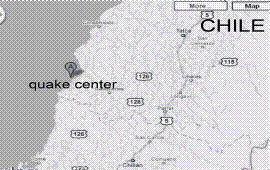
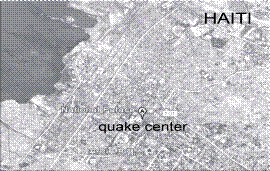
B. Power:
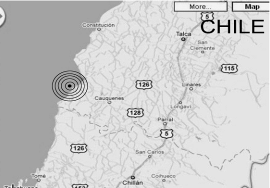

C. Building:
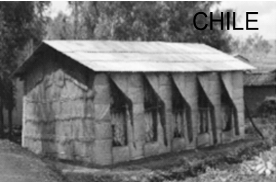

D. Rescue:
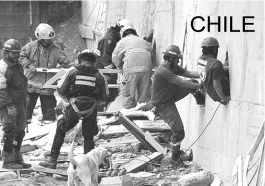
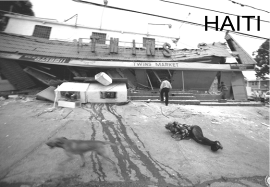
65. We can infer that the article Underwater Plate Cuts 400 Mile Gash includes ________.
A. the causes of the 2010 Chilean earthquake and the 1960 Chilean earthquake
B. the comparison between the 2010 Haitian and the 2004 Indonesian earthquakes
C. the reason for the 2010 Chilean quake being more powerful than January’s Haitian earthquake
D. the reason for less damage in the 2010 Chilean quake than in the 2004 Indonesian earthquake
66. What is the passage most likely to be?
A. A program for research. B. A guide to earthquake study.
C. An advertisement for students. D. An introduction to quakes.
查看答案和解析>>
科目: 来源: 题型:阅读理解
Quickly, the picture comes alive with hyperlinks (超链接), offering the names of the buildings, towers and street features that appear in the photo. The hyperlinks lead to information about the history, services and context of all the features in the photo. You have just hyperlinked your reality.
That might be a little unbelievable, but the technology exists and is no fevered imagination. This is not a cool small machine invented for the next James Bond movie; this is a working technology just developed by European researchers. It could be coming to a phone near you, and soon.
This, as the marketing types say, is a game changer. It develops a completely new interface (界面) that combines web-technology with the real world. It is big and fresh, but it goes much further and has much greater influence.
The development of the system is most outstanding because image recognition technology has long been pregnant with promise, but seemed to suffer from an unending labour.
Now MOBVIS has not only developed image recognition; it has also developed more applications for the technology; and it has adapted it to the world’s most popular technology: the mobile phone.
The MOBVIS system completely rewrites the rules for exploration and interaction with your physical environment. The system begins with panoramas (一连串景象). These panoramas form the basis of a city database. It can match buildings, towers, banners and even logos that appear in the panoramas.
A user simply takes a picture of the street feature, MOBVIS compares the user’s photograph to the panoramas and then identifies the buildings from the picture you take and the relevant links are returned.
Then you simply click on the links, using a touch-screen phone, and the MOBVIS system will provide information on the history, art, architecture or even the menu, if it is a restaurant, of the building in question.
67. Which is introduced in the passage?
A. A new game software. B. A popular mobile phone.
C. A cool small machine. D. An image recognition system.
68. What can we learn about the new technology?
A. It can only be put into use on mobile phones.
B. It is a little unbelievable and just a fevered imagination.
C. It has taken an unending labor to bring the technology into our lives.
D. It will encourage the users to take more pictures of the street features.
69. What is the right order of the operation of MOBVIS?
a. A city database forms in the system.
b. MOBVIS recognizes the picture and links are returned.
c. A user touches the links on the phone screen.
d. A user takes a picture of the street feature.
e. MOBVIS provides information in question.
A. a; e; c; d; b; B. a; d; b; c; e C. d; c; e; a; b D. c; a; e; b; d
70. From the passage, we can infer that _______.
A. MOBVIS has already been widely used all over the world
B. the writer is trying to promote the sales of the MOBVIS system
C. this new technology will soon be very popular in our lives
D. the sales of mobile phones will decrease as MOBVIS comes on market
查看答案和解析>>
科目: 来源: 题型:阅读理解
Waste to Energy—JUST BURN IT!
WHY BURN WASTE?
Waste-to-energy plants generate (产生) enough electricity to supply 2.4 million households in the US. But, providing electricity is not the major advantage of waste-to-energy plants. In fact, it costs more to generate electricity at a waste-to-energy plant than it does at a coal, nuclear, or hydropower plant.
The major advantage of burning waste is that it considerably reduces the amount of trash going to landfills. The average American produces more than 1,600 pounds of waste a year. If all this waste were landfilled, it would take more than two cubic yards of landfill space. That’s the volume of a box three feet long, three feet wide, and six feet high. If that waste were burned, the ashes would fit into a box three feet long, three feet wide, but only nine inches high!
Some communities in the Northeast may be running out of land for new landfills. And, since most people don’t want landfills in their backyards, it has become more difficult to obtain permits to build new landfills. Taking the country as a whole, the United States has plenty of open space, of course, but it is expensive to transport garbage a long distance to put it into a landfill.
TO BURN OR NOT TO BURN?
Some people are concerned that burning garbage may harm the environment. Like coal plants, waste-to-energy plants produce air pollution when the fuel is burned to produce steam or electricity. Burning garbage releases the chemicals and substances found in the waste. Some chemicals can be a threat to people, the environment, or both, if they are not properly controlled.
Some critics of waste-to-energy plants are afraid that burning waste will hamper (妨碍,阻碍) recycling programs. If everyone sends their trash to a waste-to-energy plant, they say, there will be little motive to recycle. Several states have considered or are considering banning waste-to-energy plants unless recycling programs are in place. Massachusetts, New Jersey, and New York City have delayed new waste-to-energy plants, hoping to increase the level of recycling first.
So, what’s the real story? Can recycling and burning waste coexist? At first glance, recycling and waste-to-energy seem to be at odds (不一致), but they can actually complement (弥补) each other. That’s because it makes good sense to recycle some materials, and better sense to burn others.
Let’s look at aluminum, for example. Aluminum mineral is so expensive to mine that recycling aluminum more than pays for itself. Burning it produces no energy. So clearly, aluminum is valuable to recycle and not useful to burn.
Paper, on the other hand, can either be burned or recycled—it all depends on the price the used paper will bring.
Plastics are another matter. Because plastics are made from petroleum and natural gas, they are excellent sources of energy for waste-to-energy plants. This is especially true since plastics are not as easy to recycle as steel, aluminum, or paper. Plastics almost always have to be hand sorted and making a product from recycled plastics may cost more than making it from new materials.
To burn or not to burn is not really the question. We should use both recycling and waste-to-energy as alternatives to landfilling.
Waste to Energy—JUST BURN IT!
| WHY BURN WASTE? | Advantages of waste to Energy | ◆Though at a high (71) _______, waste-to-energy plants can produce enough electricity for 2.4 million US households. ◆Burning waste can (72) _______ a considerable amount of trash going to landfills. |
| (73)_______ for landfilling | ◆Some communities (74) _______ land for new landfills. ◆Most people refuse to build landfills around. ◆Building landfills in far-away areas will increase the cost of (75) _______ garbage. | |
| TO BURN OR NOT TO BURN? | (76) __________ about burning garbage | ◆Burning garbage releases chemicals, which, if not properly controlled, can be (77) _______ to people and the environment. ◆Burning garbage will hamper recycling programs. |
| Coexistence of recycling and burning waste | Recycling and waste-to-energy can go well with each other in that some materials like aluminum are fit to recycle, while others like plastics are fit to (78) _______. | |
| (79)__________ | Whether to burn or not to burn, we should (80) _______ landfilling with both recycling and waste-to-energy to deal with garbage. | |
查看答案和解析>>
科目: 来源: 题型:阅读理解
Watching television more than two hours a day early in life can lead to attention problems later in adolescence, according to a study released on Tuesday.
The roughly 40 percent increase in attention problems among heavy TV viewers was observed in both boys and girls. The link was established by a long-term study of the habits and behaviors of more than 1,000 children born in Dunedin, New Zealand, between April 1972 and March 1973.
The children aged 5 to 11 watched an average of 2.05 hours of weekday television. From age 13 to 15, time spent in front of the tube rose to an average of 3.1 hours a day.
"Those who watched more than two hours, and particularly those who watched more than three hours, of television per day during childhood had above-average symptoms of attention problems in adolescence," Carl Landhuis of the University of Otago in Dunedin wrote in his report, published in the journal Pediatrics.
Young children who watched a lot of television were more likely to continue the habit as they got older, but even if they did not the damage was done, the report said.
"This suggests that the effects of childhood viewing on attention may be long lasting," Landhuis wrote.
Landhuis offered several possible explanations for the association.
One was that the rapid scene changes common to many TV programs may over stimulate(刺激)the developing brain of a young child, and could make reality seem boring by comparison. "Hence, children who watch a lot of television may become less tolerant of slower-paced and more mundane tasks, such as school work," he wrote.
It was also possible that TV viewing may supplant other activities that promote concentration, such as reading, games, sports and play, he said.
Previous studies have linked the sedentary固定不动的)habit of TV watching among children to obesity and diabetes, and another study in the same journal cited the poor nutritional content of the overwhelming majority of food products advertised on the top-rated US. children's television shows.
Up to 98 percent of the TV ads promoting food products that were directed at children aged 2 through 11 "were high in either fat, sugar, or sodium," wrote Lisa Powell of the University of Illinois in Chicago.
56. The recent survey shows that _________.
A. watching TV can cause all kinds of diseases for children
B. TV sets have played an important part in our daily lives
C. Watching TV over 2 hours a day early in life can cause attention problems later in adolescence
D. watching TV has side effects on children’s future
57. People used to think that _________.
A. watching TV more than 2 hours every day did good to children’s health
B. the sedentary habit of TV watching among children could easily lead to obesity and diabetes
C. the children wasn’t patient with their homework because of watching TV too much
D. it was very important for children to watching TV early in life
58. The underlined word “Hence” means _________.
A. In that case B. And yet C. On the contrary D. For this reason
59. In Landhuis’ opinion, _________.
A. attention problems caused by watching TV during childhood may be hard to get rid of
B. how to develop children’s attention problems is a lasting problem
C. the key of settling attention problems is not watching TV too much
D. there shouldn’t have many food products ads on children's television shows
查看答案和解析>>
湖北省互联网违法和不良信息举报平台 | 网上有害信息举报专区 | 电信诈骗举报专区 | 涉历史虚无主义有害信息举报专区 | 涉企侵权举报专区
违法和不良信息举报电话:027-86699610 举报邮箱:58377363@163.com